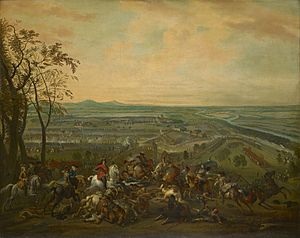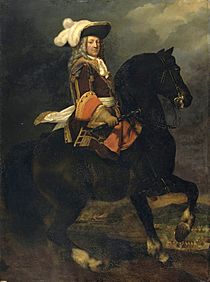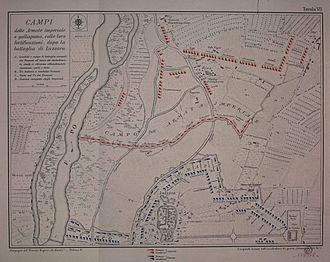Battle of Luzzara facts for kids
Quick facts for kids Battle of Luzzara |
|||||||
|---|---|---|---|---|---|---|---|
| Part of War of the Spanish Succession | |||||||
 Battle of Luzzara, by Jan van Huchtenburg |
|||||||
|
|||||||
| Belligerents | |||||||
| Commanders and leaders | |||||||
| Strength | |||||||
| 26,000 | 30,000 – 35,000 | ||||||
| Casualties and losses | |||||||
| 2,000-2,700 | 3,500-4,000 | ||||||
The Battle of Luzzara was a big fight that happened in Lombardy, Italy, on August 15, 1702. It was part of a larger conflict called the War of the Spanish Succession.
In this battle, an army from France and Savoy fought against an army from the Holy Roman Empire. The French and Savoyard forces were led by Louis Joseph, duc de Vendôme, while the Imperial army was led by Prince Eugene of Savoy.
The main reason for fighting in Northern Italy was to control important areas like Milan and Mantua. These places were key because they controlled the borders of both France and Austria.
Even though the Imperial army had fewer soldiers, they were doing well at the start of 1702. However, Vendôme's army then went on the attack. They captured towns like Modena and Reggio in July. In August, they took Luzzara, which was a very important spot because it had a crossing over the River Po.
Prince Eugene's army was in danger of being cut off from their supplies. So, he decided to attack the French at Luzzara. The fighting was tough and lasted until midnight. The Imperial army couldn't break through the French lines. They lost about 2,000 soldiers, while the French lost around 4,000.
This battle stopped Vendôme's attacks for the rest of the year. The French and Savoyard armies also managed to get back most of the land they had lost in 1701.
Contents
Why the Battle of Luzzara Happened
The War of the Spanish Succession began because Charles II of Spain, who had no children, died in November 1700. He chose Philip of Anjou, who was the grandson of Louis XIV of France, to be the next king. Philip became king of the huge Spanish Empire in November 1700. This empire included Spain, parts of Italy, and lands in Central and South America.
Other countries, like Austria, didn't want France to become too powerful. So, in 1701, France and Spain went to war against a group of countries called the Grand Alliance. The Grand Alliance wanted Charles, a younger son of the Holy Roman Emperor, to be the king of Spain instead.
The fighting in Northern Italy was about controlling Milan and Mantua. These areas were very important for Austria's safety. In March 1701, French troops took control of both cities. Victor Amadeus II, the Duke of Savoy, joined forces with France. In return, his daughter, Maria Luisa, married Philip V.
Over the next year, Prince Eugene of Savoy, an Imperial general, won several battles against the French commander Villeroi. Villeroi had to retreat. Prince Eugene even captured Villeroi in a surprise attack at Cremona in February 1702. He then started to surround Modena.
To get back control, King Louis XIV sent Vendôme to lead the French army in Italy. He also sent many more soldiers.
On July 12, Philip V joined Vendôme's army. Philip had been visiting Spanish lands in Italy. With Philip's troops, the combined French and Savoyard army grew to between 30,000 and 35,000 soldiers. This included 10,000 soldiers from Savoy and some Irish soldiers fighting for France. In July, Vendôme captured Modena and then moved north to take Guastalla. They even had a small fight with Imperial soldiers at Santa Vittoria.
In early August, Vendôme's army surrounded Luzzara. This small town was held by about 500 Austrian soldiers and had a key bridge over the Po River. Prince Eugene realized he might be cut off from his supplies at Mirandola. So, he stopped trying to take Mantua and marched towards Luzzara. He told the governor of Luzzara to hold out until he arrived.
Many of Prince Eugene's soldiers were guarding other towns, so he had about 26,000 soldiers for the battle. On August 14, he reached a village north of Luzzara. There, he found out that Luzzara had already given up, and Vendôme's main army was setting up camp nearby.
How the Battle of Luzzara Was Fought
Between Luzzara and the Po River, there were two large dirt walls, called embankments. These were built to stop the river from flooding the land. One was high and close to the town, and a smaller one was nearer the river.
Prince Eugene planned to hide his soldiers behind these walls. He hoped to surprise the French and Savoyard army, especially since they would be busy getting food and water for their horses. He split his army into two main groups. The left side was led by Visconti and Prince de Commerci. The right side was led by Vaudémont. Prince Eugene himself led the middle part of his army.
On the morning and early afternoon of August 15, Prince Eugene's soldiers crossed the Po River and moved into their positions. But a French patrol spotted them. The French and Savoyard army quickly got ready for battle. Around 5:00 pm, Prince Eugene ordered a full attack.
His right side attacked four times but was pushed back each time. Both sides lost many soldiers, especially the Irish soldiers and Albemarle's Regiment on the French side. The fighting on the other side was just as bloody. Commerci and his Danish soldiers almost broke through several times, but he and other important commanders were killed.
The rough ground made it hard for cavalry (soldiers on horseback) to join the fight. This meant that a higher number of soldiers who were actually fighting were hurt or killed. The French managed to hold their positions until it got dark and everyone was exhausted. The fighting stopped around midnight. Neither army was able to start attacking again the next morning.
Since Prince Eugene's army stayed on the battlefield, he said it was a victory for them, which was common at the time.
What Happened After the Battle

Even though Vendôme's army lost about 4,000 soldiers compared to the Imperial army's 2,000, most experts say the battle was a draw. It did stop the French from attacking further. The two armies stayed facing each other for about a month, sometimes shooting cannons at each other.
This allowed Prince Eugene to hold his ground until winter came and both armies went into their winter camps. However, the French and Savoyard forces had managed to get back all the land they had lost in the past year.
Two days after the battle, Philip V went back to Madrid. In January 1703, Prince Eugene was called back to Vienna to lead the Imperial War Council. Starhemberg took over as commander in Italy.
The war in Italy was quiet in 1703. Starhemberg had too few soldiers, and Vendôme spent most of his time helping Maximilian of Bavaria with an attack through the Tyrol that didn't work out. In October 1703, Victor Amadeus II switched sides and joined the Grand Alliance. Over the next two years, Vendôme slowly took control of most of Lombardy.
In 1708, Prince Eugene asked a Dutch artist named Jan van Huchtenburg to paint pictures of his victories, and the Battle of Luzzara was one of them.
See also
 In Spanish: Batalla de Luzzara para niños
In Spanish: Batalla de Luzzara para niños
Images for kids



